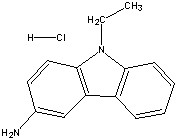
NTP Study Reports

NTP Study Reports
Home » Study Results & Research Projects » NTP Study Reports » All Long-Term Reports » Abstract for TR-93 - 3-Amino-9-ethylcarbazole Hydrochloride

| Chemical Formula: | C14H14N2 - HCl | - | 3D Structure* |
|---|---|---|---|
| *To view structure, download free Chemscape Chime Plug-in | |||
3-Amino-9-ethylcarbazole, is an aromatic amine dye intermediate that has been used industrially in the manufacture of C.I. Pigment Violet 23 and C.I. Direct Blue 108.
A bioassay of 3-amino-9-ethylcarbazole (hydrochloride) for possible carcinogenicity was conducted by administering the test chemical in feed to Fischer 344 rats and B6C3F1 mice. Both the free amine and the hydrochloride salt were used.
Groups of 50 rats of each sex and 50 mice of each sex were administered the test chemical at one of two doses, either 800 or 2,000 ppm for rats and either 800 or 1,200 ppm for mice, for 78 weeks. The rats were then observed for an additional 26-29 weeks, and the mice for an additional 16-17 weeks. Controls consisted of groups of 50 untreated rats of each sex and 50 untreated mice of each sex; separate controls were used for the groups of animals administered the different doses. All surviving rats were killed at 104-110 weeks; all surviving mice were killed at 94-97 weeks.
Since the suppliers of the low-dose rats and mice differed from those of the corresponding low-dose controls, while the suppliers for the high-dose rats and mice were the same as those of the corresponding high-dose controls, comparisons of the high-dose groups with their corresponding controls were the most appropriate. Furthermore, since the low-dose animals did not receive the same regimen of administration of the test compound as that received by the high-dose animals, and since tests using the low-dose groups were not performed concurrently with those using the high-dose groups, analyses of the dose-related trends were not possible. Although the interpretation of results of the study was based primarily on comparisons of high-dose groups with their respective controls, the results obtained with the low-dose groups, regardless of the indicated complicating factors, supported the interpretation.
Neoplasms of the liver were observed in significant incidences in rats and mice of both sexes. In male rats, hepatocellular carcinomas alone were significantly higher (P< 0.020) in both the low- and high-dose groups. When neoplastic nodules of the liver were combined with hepatocellular carcinomas, the combination occurred at significant incidences (P< 0.012) in the low- and high-dose male rats and in the high-dose female rats (males: low-dose controls 0/36, low-dose 12/42; high-dose controls 1/48, high-dose 22/48; females: high-dose controls 0/50, high-dose 6/48). Hepatocellular carcinomas alone similarly occurred at significant incidences (P<0.001) in the low- and high-dose male and female mice (males: low-dose controls 7/48, low-dose 32/44; high-dose controls 6/44, high-dose 41/49; females: low-dose controls 1/47, low-dose 36/43; high-dose controls 1/45; high-dose 43/49).
Papillomas or carcinomas of the integumentary system occurred at significant incidences (P< 0.013) in both the low- and high-dose male rats (low-dose controls 0/36, low-dose 8/44; high-dose controls 0/48, high-dose 6/48); these tumors also occurred in low- and high-dose female rats, but not at incidences high enough to be statistically significant (low-dose control 0/39, low-dose 4/44; high-dose controls 0/50, high-dose 4/49).
Carcinomas of the Zymbal's glands of the ear occurred at significant incidences (P< 0.045) in the low- and high-dose male and female rats (males: low-dose controls 0/36, low-dose 5/44; high-dose controls 0/48, high-dose 7/48; females: low-dose controls 0/39, low-dose 10/44; high-dose controls 0/50, high-dose 12/49). These tumors were first observed as early as week 47 on study.
Adenocarcinomas of the uterus or endometrium occurred at a significant incidence (P=0.002) only in the high-dose female rats (high-dose controls 1/50, high-dose 11/49); these tumors also occurred in the low-dose females, but not at an incidence high enough to be statistically significant (low-dose controls 4/38, low dose 11/43).
It is concluded that under the conditions of this bioassay, 3-amino-9-ethylcarbazole (hydrochloride) was carcinogenic for the liver, inducing hepatocellular carcinomas in Fischer 344 rats and B6C3F1 mice of both sexes. Other tumors induced in the rats were carcinomas or papillomas of the integumentary system in males, carcinomas of the Zymbal's gland of the ear in males and females, and adenocarcinomas of the uterus.
| 3-Amino-9-ethylcarbazole Hydrochloride | ||
|---|---|---|
| Male Rats: | Positive | |
| Female Rats: | Positive | |
| Male Mice: | Positive | |
| Female Mice: | Positive |
*NOTE: The technical report states that 3-Amino-9-ethylcarbazole Hydrochloride (CAS No. 6109-97-3) was the actual chemical tested rather than 3-Amino-9-ethylcarbazole in its pure form; therefore, the CAS number for 3-Amino-9-ethylcarbazole Hydrochloride is used to track this study in the NTP CHEMTRACK database.
Report Date: 1978
Target Organs from 2-year Studies
You may link to the full technical report in pdf format ( Note: A print ready copy of the document is presented in Portable Document Format (pdf) which requires the Acrobat Reader plug-in -- download a free copy of the reader.)
Web page last updated on October 15, 2007
The National Institute of Environmental Health Sciences is one of the National Institutes of Health within the U.S. Department of Health and Human Services. The National Toxicology Program is headquartered on the NIEHS campus in Research Triangle Park, NC.